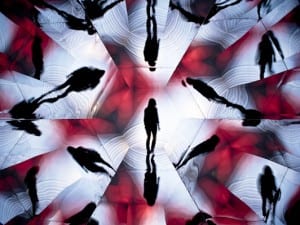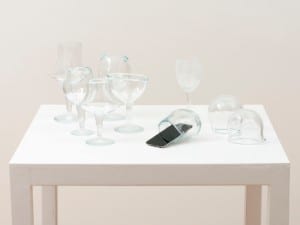In Flatlands, the stark white gallery space becomes infused with colour, revealing Batchelor’s ongoing exploration of it as a subject. Immediately upon entering the space, a long row of bright Atomic Drawings greets you. All hung on the same base line, the different paper formats and sizes become reminiscent of a city-scape as the paper rises and falls. In the Atomic Drawings, the colours are not natural colours, but those of the nocturnal light of the city, bright colours of neon’s and illuminated signs.
The construction of the drawings employs a variety of media, from more traditional forms such as pen marker and ink, to household paint and gaffer tape. There is an immediacy in the use of materials, using paper, cardboard or other studio paraphernalia. They look like sketches for potential sculptures, the geometric forms balance precariously, not quite functional, always in flux. There is a sense of potentiality within these utopian structures – an open-ended examination of the possibilities, not only of the sculptural form, but also of the materials.
Found materials are also employed in The October Colouring in Book. In its 37 years of publication, the pages of art journal October have been devoid of colour illustrations. The October Colouring in Book looks to re-address this balance. Batchelors reappropriations obliterate the theoretical language and imbed colour into the pages. In his book Chromophobia (2000), Batchelor discusses the marginalisation of colour in Western society, reducing it to the purely decorative, considered unnecessary. The circles, lines and geometric shapes that adorn the pages of October celebrate colour and form, placing it above the language of art theory, and back at the centre of artistic language.
As a tribute to pure, intense colour, paint is poured directly onto an aluminium sheet and manipulated until it finds its own form in the series of Blob paintings. Gloss or matte paint sits on the aluminium, its abstract form takes on new dimensions as the paint often ripples to create a tactile effect upon the surface. The ripples play across the painting as if to re-animate the paint, pulling it out of its 2D stasis in an attempt to reveal three dimensions.
Underneath the abstract blob sits a dark rectangle, formally read as a plinth for the abstraction to sit upon. This addition turns the abstract shape into a representational object, teasing out a sense of perception. This off circular object becomes another impossible sculpture, an unsupported burst of pure colour.
All of Batchelor’s 2D works point towards a more physical 3D installation, which is presented with Disco Mechanique. Presented next to diagrammatical and working drawings, orbs of bright sunglasses twist and rotate, reacting to the air enclosed within the gallery space. Originally commissioned for an Edwardian Ballroom during the 2008 Folkestone triennial, the spheres dance and sway emulating the movement of the forgotten dancers.
The sunglasses and circular shape of the structures reference the eye, our primary source of detecting colour. As you move around the imperfect spheres suspended from the ceiling, they merge, the colour interacts and the eye focuses on a swatch of colour before its attention is caught by another slowly spinning object. The aim of the work is optical, the phenomenology and act of looking is brought into focus as we observe the effects of colour on our ways of seeing.
Best known for his 3D work, Flatlands showcases the artists long-term engagement with drawing and painting. Drawing has been central to Batchelor’s practice, and the exhibition reveals the links between the 2D drawings and 3D sculpture. Through drawings, Batchelor is able to exercise forms that do not have to follow the laws of gravity, giving him the freedom to create forms and structures that are embedded with possibility.
In all the works, Batchelor’s ongoing exploration of colour addresses the impact it has within our everyday lives. Putting it at the forefront of all his works, we are confronted with intense bursts of colour that cannot be ignored. The colours used expose their extent and meaning, both lurid and joyful, these exuberant shades celebrate colour and the extent it plays in our perception of the modern world.
Rory Duckhouse
David Batchelor: Flatlands, Curated by Andrea Schlieker, 23 November until 26 January, Spike Island, 133 Cumberland Road, Bristol, BS1 6UX. www.spikeisland.org.uk
Image: David Batchelor Flatlands (2013) installation view. Photograph by Stuart Whipps





